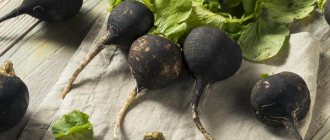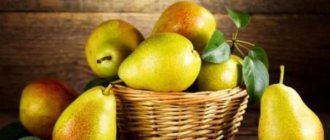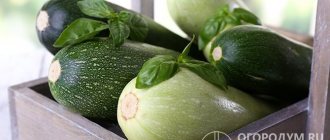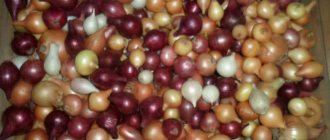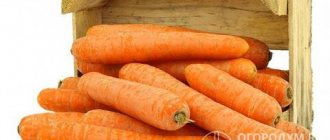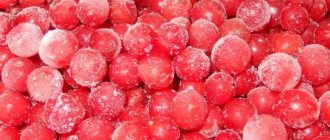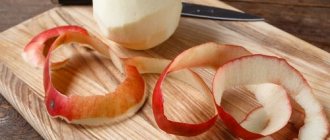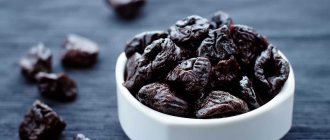Apples are a source of vitamins and microelements that are beneficial for the body. Proper collection and storage will allow you to have fragrant fruits on the table throughout the winter.
In order not to lose the harvest, it is necessary to know all the features of organizing the process of preserving fruits, including the choice of location, container, and preparatory activities.
Read the article about how to properly preserve apples at home for the winter, what you can and can’t do, and how to protect your harvest from mice and other rodents.
Conditions for storing at home in winter
For long-term storage of apples, only suitable conditions are needed. Temperature is especially important. It should be between 0ºС and +4ºС. For autumn varieties - about 0ºС. Such conditions are present in cellars and basements.
A similar temperature regime can also be obtained:
- on the balcony;
- in a refrigerator;
- in the basement or cellar;
- in a trench dug in the ground.
Violation of the minimum and maximum temperature will lead to a reduction in shelf life:
- At lower temperatures, the fruits will begin to freeze and rot.
- At temperatures above +5ºС, apples will begin to dry and wither.
In addition to temperature, additional conditions must be met for successful winter storage:
- protection from sunlight;
- humidity – 80% and above;
- protection against flooding by groundwater;
- frost protection.
You can only plant whole fruits that do not have even minor damage.
All fruits with blemishes should either be eaten immediately or processed. Those that do not have a whole stalk are also not suitable for storage during the winter, as they become open to fungal diseases.
During storage,
you should not frequently change the location of the fruit .
This is due to the fact that the conditions of detention will change, albeit slightly. As a result, the number of spoiled fruits will increase. At what temperature should apples be stored in winter at home, read here.
Temperature and humidity
Even after being removed from the branch, vital activity continues in apples:
- the apple “breathes”, absorbing carbon dioxide and releasing oxygen;
- it needs moisture for cellular metabolism;
- fermentation and ripening of the fruit takes place.
All these processes are optimal at temperatures from 0 to +4 °C. However, the variety determines a lot. The same Northern Sinap or Antonov apples prefer coolness: they are stored in conditions from -1 to +3 °C. The recommended humidity for any winter variety is 85-92%.
A slight deviation from the norm does not mean immediate damage to the winter stock. It’s just that the shelf life will be shortened, the structure of the pulp will deteriorate, and the taste of the fruit will not fully manifest itself.
Preparation
In order for the crop to be stored well all winter and even spring, you should:
- Harvest correctly.
- Sort it.
- Choose a storage location.
Before sending apples for storage, they should be sorted, sorted according to the following criteria:
- damaged and intact;
- mature and unripe;
- big and small.
Varieties
The length of storage of the crop directly depends on the variety of apples. Early and autumn fruits are not suitable for leaving into the winter. Only winter varieties need to be harvested.
Autumn varieties can also be stored, but not throughout the winter, but for a maximum of a couple of months, provided favorable conditions are provided, including a stable temperature of about 0ºC.
Popular winter varieties that have a long shelf life include:
- Semerenko;
- Antonovka;
- Golden et al.
Harvest time
Winter varieties should only be harvested when they are fully ripe. Harvesting too late or too early affects not only the appearance of the fruit, but also its taste.
In the middle zone, the first apple harvest is harvested in mid-August. But early varieties do not have a good shelf life .
Autumn varieties begin to be harvested at the border between August and September; they last longer, but not throughout the winter. Gradually they become soft and lose their taste. Winter varieties are intended for long-term storage; it is advisable to collect them from the end of September to mid-October.
You should not keep the fruits on the tree until frost , since frozen apples will not be stored all winter.
This article will tell you when to remove apples for storage.
Additional processing
Collected apples should not be rubbed, so as not to remove the natural coating on the fruit. If it is violated, the shelf life may be reduced.
Carry out additional processing:
- glycerin,
- a weak solution of potassium permanganate,
- in other ways.
You can find out how to process apples before storing them here.
Selection of containers
Most often, wooden boxes or cardboard boxes are chosen for storing apples. These methods are convenient, allowing you to compactly place the crop in the storage area. You should try to avoid contact of the fruits with each other.
For these purposes, one of the following methods is used:
- Wrap each apple separately in paper.
- Sprinkling with additional materials (shavings, sawdust, peat or sand).
- Unfolding through the gap.
Cardboard boxes, if they are chosen as containers, should first be taped at the joints or strengthened in another way so that they do not break under the weight of the apples.
General rules
Whatever storage method we use, we need to follow several rules to ensure that supplies remain fresh for as long as possible.
Varieties suitable for storage
Not all varieties of apples have equally good keeping quality. Summer varieties are stored for about two weeks, autumn varieties for a couple of months, and winter varieties can last until spring. The conditions in which the crop was grown are also of great importance. High temperatures, abundant watering, and excess nitrogen and phosphorus fertilizers during the ripening period of apples reduce their shelf life.
Here are some of the varieties recommended for winter storage:
- Antonovka;
- Pippin;
- Mac;
- Red Delicious;
- Sinap;
- Seruel;
- Verbnoe;
- Banana.
Selection and sorting
Before sorting, apples need to be quarantined. A couple of weeks in a cool room will help identify possible defects. Fruits for storage should be selected taking into account a number of practical recommendations.
- Apples must be of ripeness - not overripe or green.
- Fruits are selected without dents, wormholes or other defects.
- Different varieties need to be stored separately from each other.
- The fruits are selected to be the same size. Large ones spoil faster than small ones.
- There is no need to remove the stem; it keeps the apples longer.
- Fruits should not be washed before storing. The natural coating formed on apples during the ripening process protects them from spoilage and external influences.
Some gardeners advise treating fruits with glycerin, a solution of acetylsalicylic acid or iodinol before storing. Whether this should be done is up to you, dear readers. In the end, our efforts are aimed at preserving the beneficial properties of apples as much as possible and getting all the necessary vitamins and microelements during the winter.
Where is better?
Using boxes and crates for storage is not always possible. In some cases, a different organization is required.
A cool basement or cellar is the best place for storage . But their absence does not exclude the possibility of preserving the harvest, since it can be organized even in a city apartment.
In a refrigerator
In the refrigerator you can store not only winter apples, but also early varieties of apples that have a short shelf life.
The sooner the apples are placed in the refrigerator, the better. Ideally, they should be sent for storage within the first 24 hours after harvest.
For better preservation, all fruits should be placed in cellophane bags (no more than 2 kg each). Each of these bags should have several small holes for ventilation.
This article will tell you whether and how to store apples in the refrigerator.
In the cellar
In cellars and basements that have a humidity and temperature suitable for keeping fruit, boxes with fruit are installed only after the premises have been disinfected.
To prevent the contents of the container from being pressed down, the boxes should not be filled to the very top , much less heaped. It is convenient to install them on top of each other.
Designed for months-long storage, fruits should be compactly packed in boxes. Boxes can be installed not only on each other, but also on existing shelves. Details on storing apples in the cellar are here.
In the ground
Storing the fruit harvest directly in the ground is an option for those who do not have a cellar or basement on the site . A trench about 0.5 m deep is dug in the designated area.
Its inner part can be lined with boards or lined with branches. Apples are placed on top of them in plastic tied bags of 5 kg each.
The distance between two adjacent packages placed for long-term storage must be at least 0.2 m. An earthen trench on top:
- laid by branches;
- covered with soil;
- covered with fallen leaves and branches.
In order not to lose the storage location in winter, it should be marked at the top with a flag.
On the racks
Organized racks make it possible to conveniently and freely arrange apples in one row without touching each other.
This method provides:
- Easy access.
- Ease of inspection.
- Monitoring the quality of fruits during storage.
Racks with drawers provide additional convenience.
On the balcony
For a city dweller who does not have a cellar or a basement at his disposal, the free space on the balcony can be suitable for several boxes of apples. Not every balcony is suitable for these purposes, only those that are glazed and do not have a heating system.
If conditions on the balcony allow, you can even organize a separate thermal box. Due to the peculiarities of the organization, such a system will maintain constant temperature and humidity, regardless of external conditions.
Read more about ways to store apple harvests on the balcony here.
Vacuum packed
Vacuum packaging also allows you to preserve apples. These packages:
- retain nutrients in the product;
- prevent the formation of moisture;
- prevents the accumulation of gases released by fruits.
Only dry fruits can be placed in a vacuum bag. They are carefully folded and then sent to the refrigerator. It is advisable to keep only apples in one bag, without adding other types of fruit.
What you need to consider to preserve the harvest
If you arm yourself with the observations and recommendations of experienced gardeners, then the question of how to properly store apples will disappear by itself. You need to take the following steps step by step.
Step #1: Choose the right variety
The time during which the fruit remains unspoiled, or keeping quality, is determined by the variety.
Summer apples rot quickly and are not suitable for saving in winter. Autumn ones remain fresh for 2-3 months. Typically, gardeners pay attention to winter varieties that are stored until spring.
Top 5 most popular winter apple varieties in Russia:
- Antonovka. This is not even a variety, but a variety type, including several varieties. Described back in 1848. Residents of the middle zone appreciate Antonovka for its amazing aroma, taste, and ease of care. True, the fruits are stored only for 2-3 months.
- Bogatyr. Ripens in September. The harvest is harvested when the apple reaches full harvest ripeness. The fruit is well stored for 6 months and acquires an excellent taste for the New Year.
- Star. The apple tree produces good yields of small (weighing up to 85 g), but very tasty sweet and sour fruits, which are successfully stored until March.
- Renet Simirenko. The variety is excellent for the southern regions of the Russian Federation. Very high yield. Record holder in fruit keeping quality. Juicy apples with a spicy aroma and wine-sweet taste are stored until June.
- Northern Sinap. Apples ripen in October and hang on the branches after leaf fall. They are stored for 6-7 months. Their skin becomes oily over time, which is a varietal feature and not a sign of spoilage.
In addition to these varieties, for most regions of Russia we can also recommend:
- Pepin saffron;
- Renet Chernenko;
- Sinap Orlovsky;
- Welsey;
- Veteran.
Suitable for southern latitudes:
- Delicious;
- Memory of Michurin;
- Idared;
- Migints;
- Rossoshansky striped;
- Jonathan;
- Golden Delicious;
- Amazing;
- Korea.
For Siberia:
- Krasnoyarsk sweet;
- Treasured;
- Altai Phoenix;
- Zhivinka;
- Girlfriend;
- Lada;
- A swan song.
These winter varieties are time-tested. The fruits are stored until at least February, and some (Idared, Jonathan, Golden Delicious, Amazing, Korey) until May.
Step No. 2: Properly remove apples from the tree
Storing apples in winter directly depends on compliance with harvesting technology. There are some subtleties here:
- choose good weather for collection: no rain or wind;
- do not squeeze or scratch the fruits so as not to damage the peel;
- The stem is important for an apple, so take the fruit in your palm and twist it along with the tail;
- wear cloth gloves, this will protect the matte film on the skin from damage;
- handle the fruit carefully to avoid dents;
- Free the lower branches from the fruits first, gradually moving towards the top.
Various devices are used to remove apples from tall trees.
Do you know that…
To harvest, apples must reach removable ripeness. Each variety has its own: initial, medium or complete. You can definitely determine ripeness only by the color of the seeds. The darker the color, the riper the fruit.
Step #3: Divide by variety and size
The apple harvest is here. But don’t rush to put it away for long-term storage. Keep the harvested fruits in a cool place for 2-3 weeks to allow them to develop. After this, carry out the following activities:
- For storage, select only undamaged fruits;
- sort, put each variety in a separate box;
- divide the fruits by size and place them in different containers;
- Leave the apples with the stems on, this way they will last longer.
Do you know that…
Fruits should not be washed before storing for long-term storage; this leads to damage to the natural wax layer and rapid spoilage.
Methods and technologies for protection against mice and other rodents
To preserve the harvest, it is necessary not only to create appropriate conditions, but also to prevent damage to the harvested apples by rodents.
There are several ways to deal with the problem:
- Using poisoned baits.
The disadvantage of this method is that dead rodents can become a source of infections. In addition, with this scenario, domestic cats can be seriously harmed, even killed. - Laying elderberry branches near containers with fruits.
- Use of repellers.
General recommendations
When placing the crop, you just need to follow the basic rules and tips:
- High humidity. To prevent the apples from drying out and wilting, the humidity level should not fall below 85%. However, humidity above 95% can lead to fruit rotting.
- Low temperature. The temperature in the place where apples are stored should remain between +2 and +10 degrees Celsius.
- Lack of direct contact with other cultures. Apples are often stored in the same place as potatoes, carrots and other vegetables. This cannot be done, because as apples ripen, they emit gas, which contributes to the accelerated ripening of other crops, which will lead to their premature spoilage. In addition, the apples will be saturated with the smell of the vegetables with which they are stored.
- Pre-sorting. You need to store different varieties of crops separately, so they can be preserved longer.
If all recommendations for long-term storage of apples are followed, they can remain in the same condition and not rot for up to 6-8 months.
Deadlines
The length of time harvested crops are stored depends on a number of factors, including:
- fruit variety:
- quality of apples;
- room temperature, etc.
| Variety | Maximum storage duration, months |
| Summer | ½ — 1 |
| Autumn | Up to 2 |
| Winter | 4 — 7 |
In addition to the factors listed above, the shelf life of fruits in winter is also affected by fertilizers applied during the season . An excess, as well as a lack of fertilizing, can significantly shorten the shelf life and affect the appearance of the fruit and its taste.
For example, a large volume of nitrogen fertilizers leads to a rapid loss of fruit density, an excess of phosphorus fertilizers leads to roughness, etc.
It is also necessary to take into account that apples collected from old trees last longer than from young ones. And from the outside of the crown, and not from the inside, where the fruits receive much less light.
Read about the shelf life of apples of different varieties here.
Improving keeping quality
To preserve apples at home throughout the winter, summer residents use folk remedies. To extend the shelf life of fruits, you need:
- dip each apple in an alcohol solution of propolis;
- lubricate with glycerin, petroleum jelly;
- Apply a paraffin or wax coating.
5% salicylic acid and calcium chloride 2% saturation are also used.
Tip of the day
During storage, apples can be affected by fungal rot, so periodically sort the fruits and remove spoiled specimens.
How to store apple juice?
Natural apple juice, obtained by squeezing fresh fruit and not subjected to processing, is not stored for long. It should be drunk within an hour after preparation .
Before use, it should be kept in a glass container, covered, and in a cool place.
If the juice is being prepared for future use, after squeezing and filtering, it is heated, without bringing it to a boil, and poured into jars, which are sealed. Store the product after cooling in a dark and cool place .
You can find out how to store apple juice, including for the winter, here.
Tasty addition off topic
Cookbook by Leo Tolstoy's wife
A book with recipes from the wife of Russian writer Leo Tolstoy, Sophia, is very popular on the Internet. She was a very good housewife and prepared many delicious and satisfying apple dishes for her husband, who was a vegetarian. Below are several recipes.
Flatbread
Flatbread
Flatbread Ingredients:
- Antonovka apples – 10 pcs.
- Sugar – 410 gr
Process:
- The fruits are cut and placed in a bowl, where they are simmered until soft.
- The mass is passed through a sieve and returned to the stove again
- It’s time to add granulated sugar and chopped zest
- Stir the mixture with a spatula until it no longer leaves the sides of the pan.
- Next, everything is transferred to a metal pallet in an even layer (about 1 cm)
- The finished mass is cooled and cut into flat cakes
Cream
Cream
Cream Ingredients:
- Baked Antonovka apples – 2 tbsp.
- Granulated sugar – 2 tbsp.
- Egg – 1 pc.
- Gelatin – 1 spoon
- Vanilla – 1 piece
Process:
- Take baked, pureed apples, granulated sugar and protein. Everything is thoroughly whipped
- Gelatin is boiled. Vanilla is added next
- The prepared gelatin is transferred to the apple mixture and everything is whipped again
- The finished cream is poured into molds
Paste
Paste
Pastila Ingredients:
- Apples – 10 kg
- Sugar – 1.1 kg
- Proteins – 10 pcs.
Process:
- The fruits are baked, rubbed through a sieve and cooled overnight
- Sugar and proteins are added. The mixture is whipped until smooth
- Everything is transferred into molds and sent to the oven until ready.
How to properly store dried fruits?
Drying apples allows you to save part of the harvest in the form of dried fruits. The convenience of this method is the ability to use absolutely all varieties of apples and not throw away spoiled ones, since it is enough to simply cut off areas that are not suitable for food.
After drying by any of the methods (from drying naturally in the open air to processing in special dryers and ovens), dried fruits are packaged in one of the following options:
- They are placed in glass jars.
- They are packaged in thick paper bags.
After this, the dried fruits are placed in a dry place for storage. Read about the rules for storing dried apples here.
Sprinkling apples
Storing apples in dry fallen leaves
. To do this, put the apples in a box and sprinkle them with dry autumn leaves so that they create a layer between the fruits. Choose leaves that are undamaged, clean and dry.
Another good storage method is to sprinkle apples with wood ash mixed with sand.
in equal proportions.
Instead of foliage, you can use buckwheat husks, onion peels, husks, peat, shavings of deciduous trees, sawdust
.
Return to contents
We save seedlings
Depending on how long the seedling should be stored, the approach to solving the issue differs.
If a purchased young plant needs to be kept for a couple of weeks, you should make sure that the roots and the lump of earth do not dry out. In this case, the plant itself must be kept in a cool place, without removing the packaging, if present.
In cases where it is necessary to preserve a seedling for a long time, a more serious approach is required, including several stages:
- Unpacking and inspection of roots.
- Root pruning.
- Soil is poured into the container and roots are dug in.
- The earth is moistened.
- The seedling with the container is placed in a cool, dark place until it is planted in open ground.
This article will tell you how to preserve an apple tree seedling before planting in the spring.
Is it possible to save the harvest at home?
An underground floor in an apartment is a rare phenomenon even for the first floors; sheds can only be seen in old courtyards, and even then there are fewer and fewer of them. So how to store apples at home and is it possible? Practice shows that it is quite possible!
On the balcony
If the balcony is glazed and insulated, then it is undoubtedly suitable for storing some fruits and vegetables.
You can choose a way to store apples on a loggia or balcony from any of the options previously proposed for the cellar. Boxes with sand or sawdust and paper wrapping are also suitable.
You can build a thermal box yourself from scrap materials. You will need two boxes, slightly different in size. Lay newspapers, rags or shavings on the bottom of the larger one. The smaller box is placed inside, and the gaps between the walls are filled with insulation: the same paper or old fabric.
If you work a little and wrap each apple in a paper napkin before placing it in the resulting container, and then cover it warmly, then the fruits will be stored in this form without problems.
In a refrigerator
What to do if there is no balcony? Considering that at room temperature the supplies will quickly become unusable, there is no other option but to store apples in the refrigerator. However, there is one significant drawback of this method: it is impossible to fill the entire space of the refrigerator with fruits, because you need to keep the rest of the products somewhere.
Thus, we have to admit that for a large harvest, the refrigerator is not an option. But several bags of apples can be safely placed on the refrigerator shelf without disturbing other products.
In polyethylene bags
You can solve the problem of how to preserve apples at home using clean plastic bags. Pre-chilled fruits are hermetically packaged individually and tied tightly.
It is also possible to store fruits in large plastic bags if you place a piece of cotton wool soaked in alcohol in it and tie the container tightly. Storing apples packaged in this way is possible in the coolest place in the apartment: in the pantry, in a niche under the kitchen window or against a cold wall.
If you make homemade low-alcohol drinks from fruits, then
Paste
Natural marshmallow is one of the ways to prepare apples. This dessert keeps well. You can choose any of the methods:
- in glass jars;
- in linen bags;
- in parchment and containers.
The product is stored under the following conditions:
- temperature about +14°C;
- air humidity – up to 60%.
Before sending for storage, the marshmallow must be dried very thoroughly. Read about ways to store apple marshmallow here.
Storage problems
The weight loss of apples during storage can be 7-10%. If the conditions are created as comfortable as possible, then the natural loss will be only 3%, and in polyethylene it will be even less. However, it will be a much bigger problem if something wrong starts happening to the fruits themselves. Problems with apples during storage have different origins: some are caused by pathogenic microorganisms, others arise as a result of metabolic disorders due to unfavorable weather during fruiting of apple trees, non-compliance with agricultural practices, harvesting dates and storage conditions.
Fruit rot (moniliosis)
The disease most often occurs due to a wound on the skin of the apple, damage from codling moths, goose moths, or cracks from scab. Such fruits are still infected on the tree or already in storage. The onset of the disease appears as a brown spot, which gradually increases. Over time, the surface of the entire apple becomes brown, and then coal-black, and the flesh becomes black-brown. Interestingly, moniliosis on apples in the garden and in storage manifests itself differently. In the garden, concentric gray pads appear on the fruits, but in storage these characteristic pads do not form, the fruits simply darken very much.
Moniliosis affecting apples during storage
In order to reduce the loss of apples from moniliosis, it is necessary to store the fruits without damage, periodically sort them, and promptly remove the diseased ones. Since the initial infection occurs in the garden, it is important to protect the crop from pests and diseases by treating the trees in a timely manner.
Bitter pitting (subcutaneous spotting)
It looks like small (2-4 mm), round, depressed spots on the surface of apples. During storage, the spots turn brown and become the point where the entire fruit begins to rot. Diseased apples begin to taste distinctly bitter. The disease is caused by a lack of calcium in fruits. It develops most intensively after severe pruning, when applying large amounts of nitrogen, potassium and magnesium-containing fertilizers, as well as during a sharp transition from dry to rainy weather. Most often, large apples, as well as those grown in acidic soil, are affected by bitter pitting.
Bitter pitting often indicates a calcium deficiency
To prevent the disease, you should not get too carried away with pruning apple trees, and you should also spray them with 0.5% calcium chloride (40-60 g per 10 liters of water). The first spraying should be carried out in mid-July, subsequent spraying should be done every 2 weeks. This pre-harvest treatment increases the amount of calcium in apples.
Sunburn of fruits (brown skin, burn)
A fairly common disease that manifests itself 4-5 months after the start of storage. On apples, browning of the skin is observed, and later, rotting of the inner layers of the pulp. Large apples harvested before ripeness are more susceptible to tanning. As a rule, they are lightly colored.
Sunburn most often affects light-colored apples.
The development of the disease is prevented by eating fruits at the optimal time and wrapping them in oiled paper, especially if these are apples of uncolored varieties.
The varieties most susceptible to tanning are: Antonovka vulgaris, Northern Sinap, Sinap Orlovsky, Calvil snowy, Renet Simirenko.
Browning of the core
This occurs as a consequence of the accumulation of carbon dioxide in the tissues of fruits, which most often occurs at elevated storage temperatures. Initially, internal browning of the pulp appears around the seed nest, and then it gradually spreads to the entire pulp. Apples take on a wine-like taste. This problem also occurs when apples are stored for too long, when they have exhausted their shelf life.
Browning of the core may not be noticeable from the outside
To prevent disease, it is recommended to maintain optimal temperature conditions with good ventilation of the storage area. You should also not leave apples longer than their varietal shelf life.
Browning of the flesh
More often, the disease affects apples grown in years with cool, rainy, cloudy weather, less often in dry summers. In this case, overripe fruits, as well as those stored at zero temperature, become ill. At temperatures from 1.5 to 5 degrees, there are significantly fewer cases of the disease.
Browning of the pulp that occurs during storage of apples
The varieties most susceptible to browning of the pulp are: Antonovka vulgaris, Pepin saffron, Mekintosh, Bogatyr
The disease will not spoil apples if they are stored at a temperature of 2.5-5 degrees. Good storage ventilation and wrapping apples in oiled paper help reduce the disease. Rapid cooling of fruits when storing them should also be avoided.
Scab
When infected late in the garden, this disease is difficult to notice, and infected fruits can end up in long-term storage. After some time, small black matte, sharply defined spots appear on the apples, increasing in size. As a result, the apples crack and pathogens of various fungal diseases penetrate into the cracks.
Scab can appear on apples both in the garden and during storage.
For protection, it is necessary to treat the garden against scab, and even better, purchase apple trees that are immune to this disease.
Wilting of fruits
Observed when apples are picked early and stored in a room with low air humidity (less than 80%). At elevated temperatures, excessive ventilation.
Wilting of fruits is a sign of improper storage
The varieties most sensitive to wilting are: Wellsie, Renet Chernenko, Korichnevoe novoe, Bessemyanka Michurinskaya.
You can prevent apples from wilting by storing them in oiled paper or plastic bags and maintaining optimal air humidity.
Fruit filling (vitreousness)
This disease can be recognized by the large, irregularly shaped, translucent areas that appear on apples. On the cut, zones filled with juice are visible, most often they are located around the core. Such apples become heavy, hard, and tasteless. The disease can begin in the garden or already in storage.
Filling, or glassiness, of an apple
Most often, filling is found in varieties: Slavyanka, Antonovka ordinary, Papirovka
Fruit filling is one of the diseases caused by metabolic disorders. The cause is usually excess water content in the soil. Therefore, it is important to follow agricultural cultivation techniques, especially paying attention to optimal hydration of the trees. During storage, the disease is reduced by keeping the temperature within 2-4 degrees.
Problems and solutions
In the process of preparing apples for long-term storage, various difficulties may arise, many of which are completely solvable. Gardeners may encounter the following problems:
| Problem | Solutions | ||||
| The picked apples have too long tails, which can damage neighboring fruits. | They can be shortened a little, but should not be removed completely. | ||||
| Storage area too dry | Place a jar of water next to the apples | ||||
| Some apples in storage began to spoil | Sort through the entire harvest and remove spoiled fruits | ||||
| Apples placed in a plastic bag in the refrigerator became wet | Dry the fruit and put it in a new bag, in which you make holes for ventilation. | ||||
| Lack of sawdust and shavings for pouring layers of apples | Sawdust can be replaced with buckwheat, onion husks, and husks | ||||
| There is a large harvest of summer and autumn apples that are not stored fresh | Process fruits (make dried fruits, marshmallows, cook compotes, etc.) | ||||
| The natural waxy coating from some of the fruit has been erased | Carry out additional processing using one of the methods, for example, glycerin. Or send the fruits for processing | ||||
| All apples are different - by variety, size | Sorting, separating by variety, and among fruits of the same variety - by size | ||||
| Damage to fruits by diseases such as fruit rot, scab and others while still on the tree | They should not be used for long-term storage. If there are spots or deformed areas, the fruit should be rejected | ||||
| Damage to mold (gray, pink) and other diseases during storage | Affected fruits should be removed from storage | Black or brown spots that increase in size | Why do apples turn black? If the fruits are not too large and collected on time, then the cause of the defect is the high temperature in the vegetable storage | Vitreousness | Increased humidity during ripening, as well as storage errors (temperature violations and poor-quality ventilation) can lead to disruption of fruit formation. |
A number of problems can be avoided if you first send the apples to a six-month “quarantine”, and after two weeks, sort them again, discarding those that are damaged.
When to Harvest Apples for Long-Term Storage
It is important to adhere to the optimal timing of fruit harvesting. The later you remove from the optimal degree of maturity, the less storage potential will be. When determining the timing of harvesting, be guided by the starch content in the apple.
It is the presence of starch that determines the shelf life of the fruit. The more it is, the longer the apple is stored. During storage, starch is broken down into sugars. However, this process goes even faster while the apple is on the tree. And the later you harvest, the less starch will remain in the fruit. Accordingly, such apples are not stored for a long time.
It would seem that what prevents you from picking fruits when the starch level is at its maximum. But we need not only to preserve the apple, but also to enjoy its taste. And I think you know what an unripe green apple tastes like. Therefore, we have to look for a compromise. A good method for determining the ripeness of apples is to carry out a starch test.
The apple is cut perpendicularly and the cut is treated with a 4% iodine solution. The starch will turn blue. If the degree of coloring of the cut is 80-85%, the apple is optimal for picking. If the apple remains white, it means we are too late - the starch has broken down into sugars; it is better to use this fruit as food immediately.
If the cut remains completely blue, there is still a lot of starch, wait a few days and repeat the test. As soon as white, uncolored spots appear, it is time to harvest.
What can and cannot be done together?
When planning to store apples for the winter, you must take into account that they are stored separately from other vegetables and fruits . This limitation is due to the fact that apples stored for storage emit ethylene. This chemical stimulates the ripening of nearby fruits.
The result of such proximity may be a reduction in the shelf life of the remaining crop (carrots, potatoes, etc.) due to spoilage. In addition, the apples themselves may become saturated with an unpleasant vegetable odor, which will worsen their taste.
Is it possible to store apples in the cellar along with potatoes? You can find out here.
What is processed to make it safe?
You can increase the shelf life by treating the fruits with various preparations. But it is not advisable to mix everything together. It is better to choose one of the safest methods.
What is processed, safe methods:
- Calcium Chloride 4% (40 g) is diluted in 10 liters of water + 10 Furacilin tablets. The fruits are dipped into the solution for 10–15 minutes and then dried.
- Glycerin is applied to a soft cloth and the apples are rubbed.
- Fruits can be disinfected in a weak (pale) solution of potassium permanganate.
- The entire batch, room, and storage containers are disinfected with ultraviolet lamps (10–15) minutes.
But if the fruits are “conditionally” healthy and other conditions are fully met, then additional processing is not necessary.
Secrets of experienced gardeners
Advice from experienced gardeners will help you better preserve your apple harvest. The main recommendations include the following:
- Collect apples as carefully as possible. They cannot be wiped, poured from container to container, and especially not washed, since such actions can damage the natural waxy coating on the fruit.
- Sorting before sending for storage must be carried out.
The paper that is used to wrap apples before storage must be intended specifically for contact with food and not have a specific odor that can be transferred to the fruit.- If during storage the fruits are sprinkled with additional materials, it is necessary to ensure that they are always dry and cover the apples completely.
- Each unit of storage container (box, plastic bag, etc.) must contain fruit of the same variety.
- Wormy fruits are not suitable for winter storage.
- It is recommended to pick apples in good dry weather.
- It is recommended to harvest from the lower branches, gradually moving to the upper ones.
- Apples should be placed with their tails facing up.
- Bulk storage saves space, but often results in the loss of a significant portion of the crop. This is due to the close location of the fruits and their contact. Moreover, if one apple spoils, the neighboring ones begin to rot.
- Improper fertilizing, untimely spraying, harvesting too late and other gardener mistakes can lead to fruit damage. Such fruits should not go into storage.
Extending the shelf life of the crop can be achieved by treating with carbon dioxide, glycerin, paraffin or ultraviolet light.
How to pack apples
The question of when to collect apples for storage has already been clarified. The fruits are sorted. Now let's decide how to lay the grown crop. Every gardener finds an acceptable installation method for himself.
Easy way
In this case, the fruits are not transferred to anything.
- Arrange the apples in a container in several layers with the stem facing up.
- If the stalk is too long, shorten it. This way it will not damage neighboring fruits.
- Check the condition of the fruit often, because one rotten apple can infect the rest.
This method is simple but ineffective. To maximize shelf life, apples should be packaged or layered.
Packaging paper
The method in which each apple is wrapped in paper and placed with the tail up shows good results. Use:
- newspaper;
- napkins;
- paper towels.
Sprinkling and re-layering
You can try storing apples for the winter using a method in which the harvest is placed in cardboard boxes in layers and covered with improvised means:
- dried leaves;
- onion peel;
- sawdust;
- wood shavings;
- buckwheat peeling waste;
- husk;
- perlite or vermiculite (see “5 reasons to use perlite and vermiculite for winter storage of vegetables, fruits, rhizomes, tubers and bulbs”).
It is important that the fruits of the container do not touch, and the filled material is dry, otherwise the formation of rot cannot be avoided
Plastic bags
This method is suitable for those who have many hooks for hanging:
- Fill the bags with 2-3 kg of selected fruits.
- Tie tightly.
- Make small holes (4-5) for ventilation.
- Place it on hooks in storage.
Cling film
You will need to prepare a cardboard box and cling film:
- Line the box with cling film crosswise so that the edges hang over.
- Place the fruits in a checkerboard pattern and on their sides so that they do not touch and are not injured by the stem.
- Cover the top with the free ends of the film.
- Lay no more than 3 layers.
Do you know that…
Experienced gardeners advise using high-quality hay or straw for layering apples.
Reliable packaging
How to store dried apples? The most suitable container for storing dried apple pieces is airtight packaging.
Using it, you can ensure reliable protection of products not only from moisture and various foreign odors, but also from many pests.
Insects feed on apples, so they often sneak into loosely closed packages made of cellophane or paper. As a result, dried fruits will be spoiled by moths, bugs, flies and sugar mites, which penetrate even through an inconspicuous hole.
Dried apples are best stored in small bags made of thick fabric. In addition, cardboard boxes, tightly closed baskets, glass jars with airtight lids, and wooden boxes that insects cannot penetrate are ideal for this purpose.
It should be remembered that any selected container must first be well lined with sheets of thick paper. Preference should be given to wax paper.
The top of the fruit is also covered with paper so that it completely covers the apples. Read about how to store dried apples to prevent moths from infesting them on our website.
Variety decides the success of a business
Let's start with choosing a variety. No, we will not give long and tedious descriptions of varieties, we will say as briefly as possible which types of apple varieties will last longer, and which, no matter how hard you try, will either become loose and wadded, or even begin to rot after a week of storage.
For some, we may reveal a secret if we say that all varieties of apples are divided into categories based on keeping quality. So, when choosing a seedling, you need to find out which category of keeping quality this or that specimen belongs to (of course, if you need the fruit to last as long as possible). Typically, the highest keeping quality is observed in late, so-called winter-ripening varieties, in which the harvest begins almost the very last (in central Russia this is mid-October). There is no need to describe apple varieties; just look at the State Register and find winter varieties in the list.
Premature spoilage
How to keep apples fresh for a long time? To prolong the freshness of fruits after picking, it is necessary to learn how to properly remove them from the tree, strictly observing the recommended timing. Long-stored varieties are recommended to be harvested 1-2 weeks before full ripening. Autumn and winter varieties are most suitable for long-term storage.
It is recommended to collect fruits in dry weather; the stem should be preserved, so the apple will not wither longer.
There is a special layer on the surface of the fruit that prevents spoilage of the fruit, which is not recommended to be washed.
After harvesting, the fruits are cooled, the optimal temperature is 1-5ºC; a cellar, an insulated garage, a glazed loggia or a balcony are best suited for these purposes. Boxes or plastic bags can be used as containers.
Wrapping them in newspaper or wrapping paper will help protect the fruits from premature spoilage.
The following factors can cause premature spoilage of apples:
- overdose of nitrogen or potassium fertilizers;
- calcium deficiency in apples;
- getting infected fruits into a container with healthy ones;
- prolonged rains;
- keep warm.
You will learn how to properly prepare apples for storage in this video:
